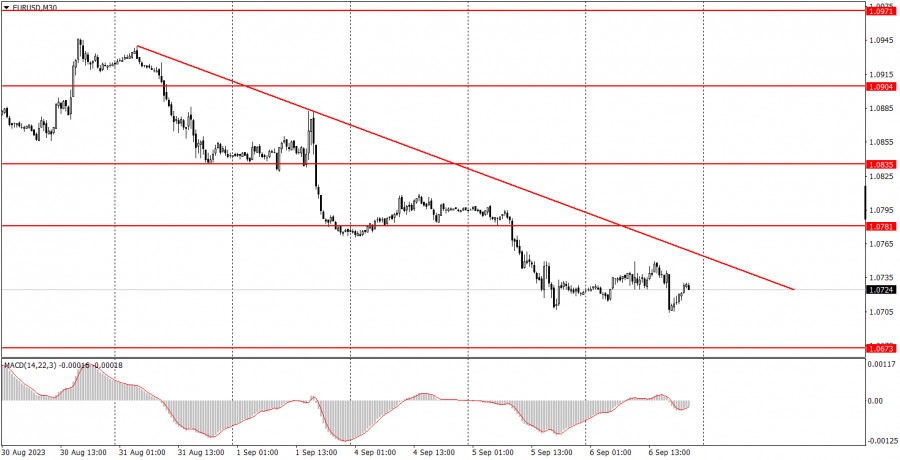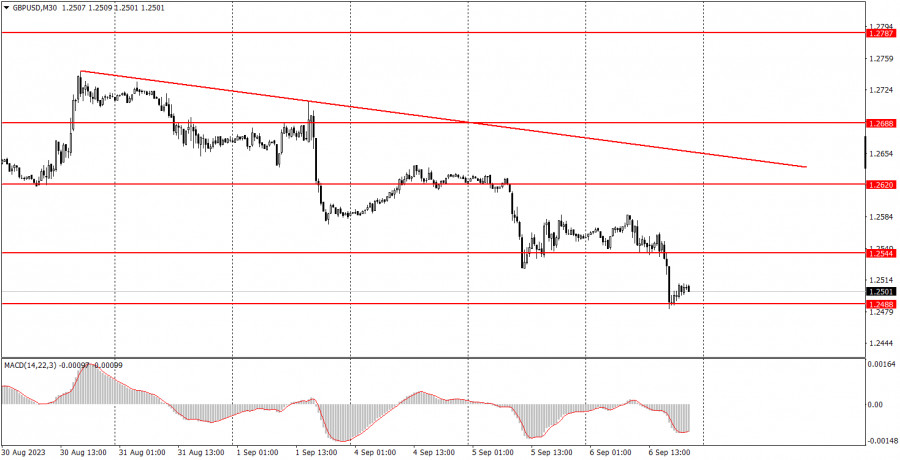Analysis of macroeconomic reports:

On Friday, the macroeconomic events on the calendar are thin, with no standout releases to note. Germany's Consumer Price Index stands as the sole report, but it's a second assessment for August. As market participants know, the initial readings typically command the lion's share of attention. Secondary estimates rarely deviate from the initial readings. Consequently, no significant market movement is anticipated in response to this data. Volatility for the major pairs may remain subdued, but the bearish trend persists in both.
Breaking down the fundamental events:
Sifting through Friday's fundamental lineup yields scant material. No scheduled remarks from ECB, Fed, or Bank of England officials are on the docket. There's a slim chance for unscheduled statements – akin to Andrew Bailey's unannounced early-week address. Still, hopes for such surprises are dim. Recent ECB commentary appears to lean towards a pause in tightening monetary measures. Bank of England's representatives continue to be notably tight-lipped. As for the Fed, eyes are squarely on the upcoming inflation report, which will be pivotal for the September rate decision.
General conclusion:
On Friday, no significant events are scheduled that could draw the attention of beginning traders. The volatility in both pairs is likely to be subdued, which will affect the trading. With no definite movements, trading will be quite challenging. The market may be flat again.
Basic rules of a trading system:
1) Signal strength is determined by the time taken for its formation (either a bounce or level breach). A shorter formation time indicates a stronger signal.
2) If two or more trades around a certain level are initiated based on false signals, subsequent signals from that level should be disregarded.
3) In a flat market, any currency pair can produce multiple false signals or none at all. In any case, the flat trend is not the best condition for trading.
4) Trading activities are confined between the onset of the European session and mid-way through the U.S. session, post which all open trades should be manually closed.
5) On the 30-minute timeframe, trades based on MACD signals are only advisable amidst substantial volatility and an established trend, confirmed either by a trend line or trend channel.
6) If two levels lie closely together (ranging from 5 to 15 pips apart), they should be considered as a support or resistance zone.
How to read charts:
Support and Resistance price levels can serve as targets when buying or selling. You can place Take Profit levels near them.
Red lines represent channels or trend lines, depicting the current market trend and indicating the preferable trading direction.
The MACD(14,22,3) indicator, encompassing both the histogram and signal line, acts as an auxiliary tool and can also be used as a signal source.
Significant speeches and reports (always noted in the news calendar) can profoundly influence the price dynamics. Hence, trading during their release calls for heightened caution. It may be reasonable to exit the market to prevent abrupt price reversals against the prevailing trend.
The material has been provided by InstaForex Company - www.instaforex.comfrom Forex analysis review https://ift.tt/7iMUl9w
via IFTTT

